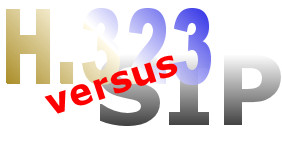
Response to "Voice Over Internet Protocol (VoIP) - current technology and comparison of H.323 with SIP"
From: Paul Long [mailto:plong@packetizer.com]
Sent: Monday, September 17, 2001 3:22 PM
To: taegon@stanford.edu; chuhee@stanford.edu
Cc: paulej@packetizer.com; Naidu, Venkata
Subject: Voice Over Internet Protocol (VoIP) - current technology and comparison of H.323 with SIP -
Gentlemen,
I have some comments regarding your comparison at http://www.stanford.edu/~chuhee/project/index.htm.
Content description/Capability Exchange - As of v2, defined three-and-a-half years ago, H.323 can do this without H.245 at all by using Fast Connect on the call-signaling channel. Also, H.323 never has been and is not now "restricted to ITU-T codecs only." There have been ASN.1 codepoints for MPEG and GSM codecs for quite some time, many vendors support proprietary codecs through NonStandardParameters, which is equivalent to SIP's "privately named codec by mutual agreement," and any codec regardless of whether it is defined by the ITU-T can be signaled via the GenericCapability feature that was added two years ago in H.323v3.
(Minor point, but it's "H.225.0" and not "H.225." In the ITU-T, these things matter. For example, G.723 is different than G.723.1.)
Architectural Complexity - I think you should point out that H.323 is largely a unified standard whereas SIP expects each vendor to decide how to integrate various other standards into SIP. This increases the complexity of implementing SIP. Moreover, you should count the size of all those other standards that SIP needs in order to be functionally equivalent to H.323 in order to calculate the total complexity of SIP. If you do not go to the trouble of doing this, at least make this point in your comparison.
Protocol Encoding/Decoding - The binary-encoding thing has never been an issue with the H.323 crowd. I even once proposed having a textual encoding, but nobody was interested.
Support for Large Number of Domains - Way back in 1996, H.323v1 referred to LANs in its title and elsewhere. However, it also says in the Summary, "The LAN over which H.323 terminals communicate, may be a single segment or ring, or it may be multiple segments with complex topologies." The latter is otherwise known as a "WAN." H.323 has never been only for LANs and references to "LAN" were removed as of the second version.
Support for Large Number of Calls - How do you know this: "SIP takes less CPU cycles to generate signaling messages." If you do not know this for a fact, you should not state it as such. I do not know either but wouldn't be surprised if text processing consumed as many or more cycles as binary processing. Consider similar comparisons, e.g., accessing textual versus binary databases and executing textual interpreters versus binary executables.
Connection State - Although it seems that most and possibly all UAs signal the end of a call, the BYE message is technically optional, so it may not always be clear when or whether a SIP call has terminated. I think this should be mentioned in your comparison.
Address-Format Neutrality - It is not true that all aliases (in the generic sense) must be translated by the gatekeeper. It falls outside the Recommendation, but an EP can resolve aliases by any way it wants. In fact, many PC-based terminals do just that, e.g., if the EP is not registered, it contacts DNS in an attempt to resolve the alias.
Security - This falls outside of the standard, but H.323 entities could also use SSL for transport-layer security.
Interoperability among Implementations - The H.323 Implementers Guide does not addres interoperability issues. It is a addendum/corrigendum to the current H.323 Recommendation, and its contents is folded into the next version.
Interoperability with Other Signaling Protocols - H.323 does not "embrace the more traditional circuit-switched approach." It is 100% packet switched. A small part of it (modified Q.931 message formats) is borrowed from ISDN, but there is nothing "circuit switched," per se, about H.323. It is easier to integrate it rather than SIP with the PSTN, though.
(Another minor point: I know that many people, including myself, refer to the different versions of H.323; however, as far as the ITU-T is concerned, there is only one version of H.323 that is updated periodically. For example, one cannot obtain an official copy of the previous "versions.")
Paul Long
